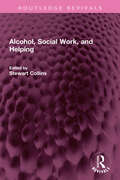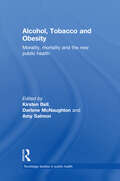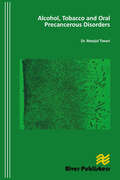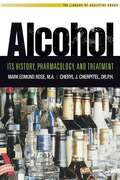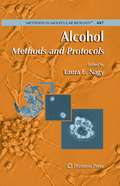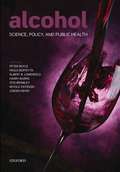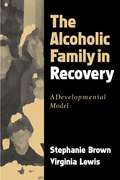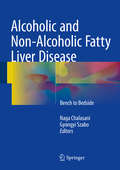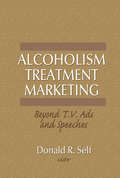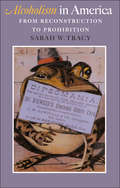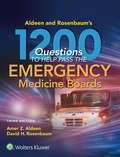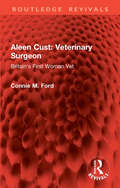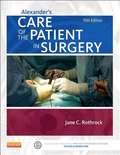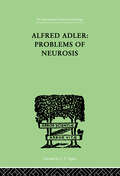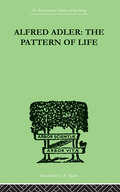- Table View
- List View
Alcohol, Nutrition, and Health Consequences (Nutrition and Health)
by Victor R. Preedy Ronald Ross Watson Sherma ZibadiChronic alcohol use is associated with heart, liver, brain, and other organ pathology. Alcohol is a drug of abuse and a caloric food and it causes poor intake and absorption of nutrients, thus playing a major role in many aspects of clinical consequences. Alcohol use lowers consumption of fruit and vegetables, lowers tissue nutrients, and, in some cases, requires nutritional therapy by clinicians. Alcohol, Nutrition, and Health Consequences will help the clinician define the causes and types of nutritional changes due to alcohol use and also explain how nutrition can be used to ameliorate its consequences. Chapters present the application of current nutritional knowledge by physicians and dietitians. Specific areas involving alcohol-related damage due to nutritional changes are reviewed, including heart disease, obesity, digestive tract cancers, lactation, brain function, and liver disease. In addition, alcohol's effects on absorption of minerals and nutrients, a key role in causing damage are treated. The importance of diet in modifying alcohol and its metabolite damage is also explained. Alcohol, Nutrition, and Health Consequences is essential reading for alcohol therapists and researchers as well as primary care physicians and dietitians and is an easy reference to help the clinician, student, and dietitian comprehend the complex changes caused by direct and indirect effects of ethanol at the cellular level via its nutritional modification.
Alcohol, Power and Public Health: A Comparative Study of Alcohol Policy
by Shane Butler Betsy Thom James Nicholls Karen ElmelandIn recent years, the reduction of alcohol-related harm has emerged as a major policy issue across Europe. Public health advocates, supported by the World Health Organisation, have challenged an approach that targets problem-drinking individuals, calling instead for governments to control consumption across whole populations through a combination of pricing strategies, restrictions on retail availability and marketing regulations. Alcohol, Power and Public Health explores the emergence of the public health perspective on alcohol policy in Europe, the strategies alcohol control policy advocates have adopted, and the challenges they have faced in the political context of both individual states and the European Union. The book provides a historical perspective on the development of alcohol policy in Europe using four case studies – Denmark, England, Scotland and Ireland. It explores the relationship between evidence, values and power in a key area of political decision-making and considers what conditions create – or prevent – policy change. The case studies raise questions as to who sets policy agendas, how social problems are framed and defined, and how governments can balance public health promotion against both commercial interests and established cultural practices. This book will be of interest to academics and researchers in policy studies, public health, social science, and European Union studies.
Alcohol, Social Work, and Helping (Routledge Revivals)
by Stewart CollinsFirst published in 1990, Alcohol, Social Work and Helping provides coherent and imaginative advice on how to counsel the growing number of clients whose use of alcohol causes of problems. It locates intervention within societal and agency contexts and tackles such practical issues as: how to work with a problem drinker; which short-term goals to suggest; what kind of help to apply; and how to assist in the event of a relapse. The contributors, with backgrounds in academic, statutory, and voluntary settings, focus on key areas of intervention, family, and group contexts, and there is a chapter on the particular circumstances and needs of women. All relevant information – both general and specialized – is presented in a clear, easy-to-read style, and is aimed at developing existing knowledge and skills. This book will be of interest to students of health, social work, and sociology.
Alcohol, Tobacco and Obesity: Morality, mortality and the new public health
by Amy Salmon Kirsten Bell Darlene McNaughtonAlthough drinking, smoking and obesity have attracted social and moral condemnation to varying degrees for more than two hundred years, over the past few decades they have come under intense attack from the field of public health as an 'unholy trinity' of lifestyle behaviours with apparently devastating medical, social and economic consequences. Indeed, we appear to be in the midst of an important historical moment in which policies and practices that would have been unthinkable a decade ago (e.g., outdoor smoking bans, incarcerating pregnant women for drinking alcohol, and prohibiting restaurants from serving food to fat people), have become acceptable responses to the 'risks' that alcohol, tobacco and obesity are perceived to pose. Hailing from Canada, Australia, the United Kingdom and the USA, and drawing on examples from all four countries, contributors interrogate the ways in which alcohol, tobacco and fat have come to be constructed as 'problems' requiring intervention and expose the social, cultural and political roots of the current public health obsession with lifestyle. No prior collection has set out to provide an in-depth examination of alcohol, tobacco and obesity through the comparative approach taken in this volume. This book therefore represents an invaluable and timely contribution to critical studies of public health, health inequities, health policy, and the sociology of risk more broadly.
Alcohol, Tobacco and Oral Precancerous Disorders
by Munjul TiwariIt is estimated that in India 75% of cancers of oral cavity are attributable to tobacco chewing, smoking and alcohol drinking. So the purpose of this book is to present the correlations of these premalignant disorders microscopically with in tobacco users and alcohol drinkers.
Alcohol/Drug Screening and Brief Intervention: Advances in Evidence-Based Practice
by Richard Saitz Mark GalanterGet a better understanding of what is known and what is not known in this widespread practice Screening and brief intervention (SBI) has been around for over 40 years and is a widely recognized practice. Alcohol/Drug Screening and Brief Intervention: Advances in Evidence-Based Practice provides a valuable exploration of the present literature, the effectiveness and cost-effectiveness of screening and brief intervention, and methodological challenges in studying these practices. Respected leaders in the field discuss ways to measure the use of screening and brief intervention in practice, the multiple risk factor context in which unhealthy alcohol use occurs, clinician training issues, effective strategies to screen adolescents, which patients are most likely to change from SBI, and what research is needed in the future. Screening and brief intervention are presently being used in numerous settings such as hospitals, primary care settings, trauma centers, and college health services. Alcohol/Drug Screening and Brief Intervention: Advances in Evidence-Based Practice examines in detail original research and cutting edge research issues in these settings to provide an important review of what is known and what is not known about the practice. Methodological issues are extensively discussed. This valuable book provides crucial information on the detection of small effects, standards of analysis, reporting, interpretation, the risks of bias, and the need to ensure that results have the potential to be applied in practice. Health professionals and addiction specialists get an important critical re-evaluation of the growing practice and are provided direction for future research. Other topics in Alcohol/Drug Screening and Brief Intervention: Advances in Evidence-Based Practice include: results of research on screening, brief intervention, and referral to treatment (SBIRT) exploration of data assessing the effectiveness of screening and brief alcohol intervention evaluation of clinical alcohol screening with the AUDIT-C cost-effectiveness and cost-benefit of SBI in medical settings research into SBIRT for Emergency Departments data on primary care patients with multiple risk factors research on feasibility and efficacy of "no-contact" interventions and more! Alcohol/Drug Screening and Brief Intervention: Advances in Evidence-Based Practice is essential reading for alcohol and drug researchers, screening and brief intervention program practitioners, physicians, nurses, health promotion advocates, Public Health Practitioners, and the State Departments of Public Health.
Alcohol: It's History, Pharmacology and Treatment
by Cheryle J. Cherpital Mark Edmund RoseThe definitive guide to the effect of alcohol on people, families, communities, and society, written by two of America's leading experts on alcoholism and its impact.Throughout history, and across cultures, alcohol has affected the fabric of society through abuse and addiction, contributed to violence and accidents, and caused injuries and health issues. In Alcohol: Its History, Pharmacology, and Treatment, part of Hazelden's Library of Addictive Drugs Series, Cheryl Cherpitel, DrPH, and Mark Rose, MA, examine the nature and extent of alcohol use in the United States, current treatment models and demographics, and the biology of alcohol, addiction, and treatment.In separating fact from fiction, Cherpitel and Rose give context for understanding the alcohol problem by tracing its history and different uses over time, then offer an in-depth look atthe latest scientific findings on alcohol's effects on individualsthe myths and realities of alcohol's impact on the mindthe societal impacts of alcohol abuse as a factor in violence and accidentsthe pharmacology of pharmaceutical treatments for alcoholismthe history of treatment and current therapeutic treatment modelsThoroughly researched and highly readable, Alcohol offers a comprehensive understanding of medical, social, and political issues concerning this legal, yet potentially dangerous, drug.
Alcohol: Methods and Protocols (Methods in Molecular Biology #447)
by Laura E. NagyThis book examines the pleiotropic effects of ethanol in animal and cell culture models through a collection of detailed procedures written by experts in the field. Sections present clearly defined models of ethanol exposure, recent advances in the development of specific methodologies to mimic the impact of ethanol metabolism in cultured cells, and methodologies to investigate a variety of cells and tissues that are known to be disrupted by ethanol, amongst other topics.
Alcohol: Science, Policy and Public Health
by Paolo Boffetta Peter Boyle Albert B. Lowenfels Harry Burns Otis Brawley Witold Zatonski Jürgen RehmAlcohol has always been an issue in public health but it is currently assuming increasing importance as a cause of disease and premature death worldwide. Alcohol: Science, Policy, and Public Health provides an interdisciplinary source of information that links together, the usually separate fields of, science, policy, and public health. This comprehensive volume highlights the importance of bringing scientific knowledge to bear in order to strengthen and develop alcohol public policy. The book looks at the historical evolution of alcohol consumption in society, key early studies of alcohol and disease, and the cultural and social aspects of alcohol consumption. It then goes on to cover the chemistry and biology of alcohol, patterns of consumption, gender and age-related issues, alcohol and injury, alcohol and cancer and non-malignant disease, and various current therapeutic aspects. The book concludes with a section on alcohol policy, looking at issues of poverty, the availability of alcohol and alcohol control measures. This major reference, written by international leaders in the fields of alcoholism and alcohol policy, provides a comprehensive study of one of the foremost health problems in the world, and represents the highest standards of research within the field. It will be valuable to physicians and health professionals involved with patients with alcohol-related problems, scientists, public health specialists, health policy specialists, researchers and legislators as well as students of public health.
Alcoholic Family in Recovery
by Stephanie Brown Virginia M. LewisMost treatments for alcoholism have focused on abstinence as their final goal and emphasize brief interventions with the addicted individual. But family relationships change dramatically when the alcoholic stops drinking in fact, stress, turmoil, and uncertainty are the norm. This volume details how to help families regroup after abstinence, ride out periods of emotional upheaval, and find their way to establishing a more stable, yet flexible, family system. Using a compelling case-study format to illustrate the process of change, the book presents the moving personal experiences of families at different stages of the recovery process. Expanding the therapist's role to include psychoeducation and supportive counseling, the authors provide pointers for assessment at key stages of recovery and guide clinicians through bringing about lasting change.
Alcoholic and Non-Alcoholic Fatty Liver Disease: Bench to Bedside
by Naga Chalasani Gyongyi SzaboThis volume is the first text to concisely yet comprehensively cover developments for both alcoholic and nonalcoholic fatty liver disease in an organized fashion. Aspects of these two diseases covered in the book include global epidemiology and risk factors, pathogenesis, animal models, hepatic and extra-hepatic malignancies, treatment models, and current and emerging therapies. Written by experts in the field, Alcoholic and Non-Alcoholic Fatty Liver Disease: Bench to Bedside is a valuable resource for gastroenterologists, pathologists, and hepatologists who treat patients with alcoholic and nonalcoholic fatty liver disease.
Alcoholic/Non-Alcoholic Digestive Diseases
by Hitoshi Yoshiji Kosuke KajiThis book describes the latest advances concerning the molecular mechanisms of and therapeutic strategies for alcohol- and non-alcohol-related digestive diseases. Alcohol abuse causes not only liver injury but can harm various organs, resulting in esophageal and colorectal cancers, GERD, pancreatitis, etc. Similar to alcoholic abuse, metabolic syndrome based on obesity and diabetes is also strongly associated with the development of various digestive diseases. Although these diseases may be differentiated by the presence or absence of alcohol intake, the pathologic findings and pathogenesis reveal a number of similarities. This volume covers clinical and basic approaches for esophageal, gastric, hepatic, colorectal and pancreatic diseases associated with alcohol abuse and metabolic syndrome; further, it discusses the roles of microbiota, oxidative stress, and apoptosis, the critical factors causing alcoholic and metabolic digestive diseases. Also, it showcases new pathological and therapeutic perspectives in gastric and pancreatic cancers. Alcoholic/Non-Alcoholic Digestive Diseases will provide invaluable information for doctors specializing in gastroenterology and hepatology and researchers seeking new research on digestive diseases based on alcohol consumption and obesity.
Alcoholism Treatment Marketing: Beyond T.V. Ads and Speeches
by Donald SelfThe annual economic burden of alcohol abuse in the United States is staggering, yet the alcoholism treatment industry has been historically plagued by governmental regulations, moral crusades, advocacy of specific treatment approaches, and a lack of marketing knowledge. Here is the first focused set of research on the marketing of alcoholism treatment services. The authors of this much-needed volume--reputable marketing and research scholars--greatly expand the current base of knowledge concerning the alcohol treatment marketing subdiscipline, including the referral system analyses of market potentials for providers, promotional effort consultation for new providers, and the evolving nature of medical services distribution systems. Through in-depth interviews with treatment providers, referral sources, and former clients of treatment facilities, and in major reviews of literature on the subject, Alcoholism Treatment Marketing presents primary research and general research findings to provide practical marketing implications.
Alcoholism in America: From Reconstruction to Prohibition
by Sarah W. TracyDespite the lack of medical consensus regarding alcoholism as a disease, many people readily accept the concept of addiction as a clinical as well as a social disorder. An alcoholic is a victim of social circumstance and genetic destiny. Although one might imagine that this dual approach is a reflection of today's enlightened and sympathetic society, historian Sarah Tracy discovers that efforts to medicalize alcoholism are anything but new.Alcoholism in America tells the story of physicians, politicians, court officials, and families struggling to address the danger of excessive alcohol consumption at the turn of the century. Beginning with the formation of the American Association for the Cure of Inebriates in 1870 and concluding with the enactment of Prohibition in 1920, this study examines the effect of the disease concept on individual drinkers and their families and friends, as well as the ongoing battle between policymakers and the professional medical community for jurisdiction over alcohol problems. Tracy captures the complexity of the political, professional, and social negotiations that have characterized the alcoholism field both yesterday and today.Tracy weaves American medical history, social history, and the sociology of knowledge into a narrative that probes the connections among reform movements, social welfare policy, the specialization of medicine, and the social construction of disease. Her insights will engage all those interested in America's historic and current battles with addiction.
Aldeen and Rosenbaum's 1200 Questions to Help You Pass the Emergency Medicine Boards
by Amer Aldeen David H. RosenbaumFully revised and updated based on valuable reader feedback, Aldeen and Rosenbaum's 1200 Questions to Help You Pass the Emergency Medicine Boards, Third Edition gives you the tools you need to pass the ABEM board exam on the first try. Questions are slightly more difficult than the average exam question, in order to challenge and add to your knowledge and fully prepare you for questions you’re likely to see. Every question in this Third Edition has been reviewed for quality and relevance, ensuring that this unique study tool is an ideal choice to prepare for both the in-service residency exam and the board exam in emergency medicine.
Aldehyde Dehydrogenases: From Alcohol Metabolism to Human Health and Precision Medicine (Advances in Experimental Medicine and Biology #1193)
by Jun Ren Yingmei Zhang Junbo GeThis volume covers the science of ALDH enzymes in relation to chronic disease processes and the future therapeutic potentials of targeting ALDH in these processes. It thoroughly reviews the roles of ALDH family in alcohol metabolism, as well as recent findings of their emerging roles in a variety of human pathologies such as cardiovascular diseases, diabetes, obesity, stroke, cancer, liver diseases and kidney diseases. Delicate contribution of ALDH enzymes in the therapeutics against chronic diseases is also discussed. It demonstrates the unique value of targeting genetic polymorphism in ALDH enzymes in personalized medicine. The book will appeal to scientists, physicians, graduate and professional students in the fields of ALDH enzymes, alcohol metabolism, cardiometabolic and other chronic diseases. Pharmaceutical and other companies developing new tools for cardiometabolic and chronic diseases treatment will also find this a valuable resource.
Aleen Cust Veterinary Surgeon: Britain's First Woman Vet (Routledge Revivals)
by Connie M. FordOriginally published in 1990, this book is a valuable contribution to the history of the veterinary profession in Great Britain and Ireland. Connie Ford’s book is a reminder of the great social changes that have taken place since Aleen Cust was born in 1868. When Aleen Cust entered the New Veterinary College, Edinburgh in 1895, and was later refused permission to sit the examinations of the Royal College of Veterinary Surgeons, no British woman had the vote. To the women students, only admitted to the London Veterinary College in 1927, she was a legend and an example. Now, a new generation of veterinarians, will find this account of the life and times of a truly remarkable woman a revelation.
Alejandro's Sexy Secret
by Amy RuttanWhat happens in Vegas stays in Vegas... If only that were true! Surgeon Kiri Bhardwaj never expected to see sexy exotic dancer Alejandro Valentino again after their fantasy life-changing night together. But now they're face-to-face, and he's a specialist in her pediatric department! Working with Kiri proves to Alejandro that they haven't finished what they started all those years ago. But to claim what he's lost he'll have to lay his heart on the line and prove to Kiri their chemistry is for keeps!
Alessandro and the Cheery Nanny
by Amy AndrewsHigh-flying surgeon meets a real-life Mary Poppins! Italian surgeon Alessandro Lombardi had it all- distinguished career, newborn heir, beautiful wife. But that life is gone forever now, and he and his little boy have come to Australia to start over. Things start looking up when bubbly nanny and ER nurse Natalie Davies and her mischievous kitten move in! They put the smile back on his son's sad face, and Natalie ignites a flame in Alessandro's deeply guarded heart. Nat hides her own heartache behind her twinkling eyes, but she's already fallen for Alessandro's little boy, and she knows she's in danger of tripping head over heels for a man who has sworn never to love again...
Alex: The Life of a Child
by Frank DefordFrank DeFord tells the heartbreaking, yet uplifting story of his daughter Alex's brief life. She died of cystic fibrosis at the age of eight.
Alexander's Care of the Patient in Surgery
by Jane C. RothrockAlexander's Care of the Patient in Surgery is the most dependable source for comprehensive perioperative information. Well-known author and educator, Jane C. Rothrock, continues to provide step-by-step instructions for over 400 surgical procedures, including many minimally invasive methods, all backed by the latest research. More than 1,000 full-color illustrations and photos depict current techniques, as well as surgical anatomy and instrumentation. This edition adds cutting-edge information to reflect new concepts for both invasive and non-invasive surgical procedures, whether the location is in a hospital, outpatient clinic, or doctor''s office. Over 400 specialty surgical interventions are included, as well as many minimally-invasive surgical procedures. A clear and consistent chapter format makes it easy to find information, including general discussions of surgical anatomy and perioperative nursing considerations, followed by more specific discussions of procedural considerations and operative procedure for each surgical intervention. Cutting-edge information keeps you up-to-date with the latest technological advances related to surgical procedures, both invasive and non-invasive, whether the location is in a hospital, outpatient clinic, or in a doctor''s office. Updated coverage includes new surgical procedures and techniques, new care standards, and the importance of integrating evidence and research into patient care. 1,000 full-color illustrations and photos show surgical anatomy, procedures, and methods. Comprehensive discussions of perioperative nursing considerations cover assessment, nursing diagnosis, outcome identification, planning, implementation, evaluation, patient and family education, and discharge planning. Full-color design highlights special features and makes it easier to focus on essential concepts. Patient Safety boxes highlight Joint Commission initiatives and important safety topics. Evidence for Practice boxes apply scientific research to perioperative nursing. Research Highlight boxes provide the latest research and apply it to patient care. Patient and Family Education boxes include specific guidelines for preprocedural and postprocedural care, side effects and complications, home care, discharge/follow-up care, psychosocial care, and referrals. Surgical Pharmacology tables summarize and offer quick reference to the drugs most commonly used for specific surgical procedures, including generic and trade names, purpose/description, and pharmacokinetics. Ambulatory Surgery Consideration boxes highlight patient selection criteria, special anesthesia considerations, and patient assessment implications for outpatient surgical procedures. Sample plans of care include nursing diagnosis, outcome, and interventions, linking specific interventions to clearly identified outcomes. An emphasis on patient and workplace safety includes protocols from the major safety agencies and coalitions, perioperative nursing safety issues, patient rights, and safe patient handling and movement. Coverage of cross-specialty areas includes special considerations for pediatric, geriatric, and trauma surgeries, as well as interventional and image-guided procedures, and complementary and alternative therapy. NEW and UNIQUE! Patient-Centered Care boxes feature simplified conversations that you can have with patients to help them better understand their surgical procedure. NEW! A Critical Thinking Question at the end of every chapter tests your understanding of chapter content. NEW! Key Points at the end of every chapter help you retain important concepts from the text. NEW! Laboratory Values appendix contains all laboratory value information in one convenient location
Alexia: Diagnosis, Treatment and Theory
by Alexander Leff Randi StarrfeltThis book is a comprehensive review of the main acquired disorders of reading: hemianopic, pure and central alexia. The authors review the diagnostic criteria for each of the different types of disorder, and the efficacy of the therapeutic studies that have attempted to remediate them. The different theoretical models of adult reading, which largely rest on how the reading system responds to injury, are also discussed and evaluated. Focal brain injury caused by stroke and brain tumors are discussed in depth as are the effects of dementia on reading. This book starts with a chapter on normal reading, followed by chapters on hemianopic alexia, pure alexia and central alexia, each structured in the same way, with: a description of the condition; a historical review of cases to date; psychophysics; consideration of the causative lesions; evidence from functional imaging studies on patients and, most importantly, a review of the evidence base for treating each condition. Finally, there is a chapter on how patient data has informed how we think about reading. Alexia: Diagnosis, Treatment and Theory is aimed at neuropsychologists (both experimental and clinical), neurologists, speech therapists and others who deal with patients whose reading has been affected by an acquired brain injury, as well as interested students studying language disorders.
Alfred Adler: A Book of Case-Histories (International Library Of Psychology Ser.)
by Mairet, PhilippeFirst Published in 1999. Routledge is an imprint of Taylor & Francis, an informa company.
Alfred Adler: The Pattern of Life
by W. Beran WolfeFirst Published in 1999. Routledge is an imprint of Taylor & Francis, an informa company.
Algae Refinery: Up- and Downstream Processes (Greener Technologies For Sustainable Industry And Environment)
by Pradeep Verma Sanjeet MehariyaAlgae Refinery: Up- and Downstream Processes offers complete coverage of algae refinery, including up- and downstream processes while proposing an integrated algal refinery for the advancement of existing technologies and summarizing the strategies and future perspectives of algal refinery. It provides a concise introduction to the algal science, biology, technology, and application of algae. It explains downstream and upstream steps of algal refinery for the production of algal biomass, with several social benefits. Features: Provides various aspects of algal bioprocess including upstream and downstream processes Explains the major research streams of algae structures and their pathways Covers algal-based CO2 capture technology Explores the potential applications of algae for socioeconomical benefits Deliberates algal bioremediation approach for clean and sustainable development


